|
41 Townwall Street
Dover
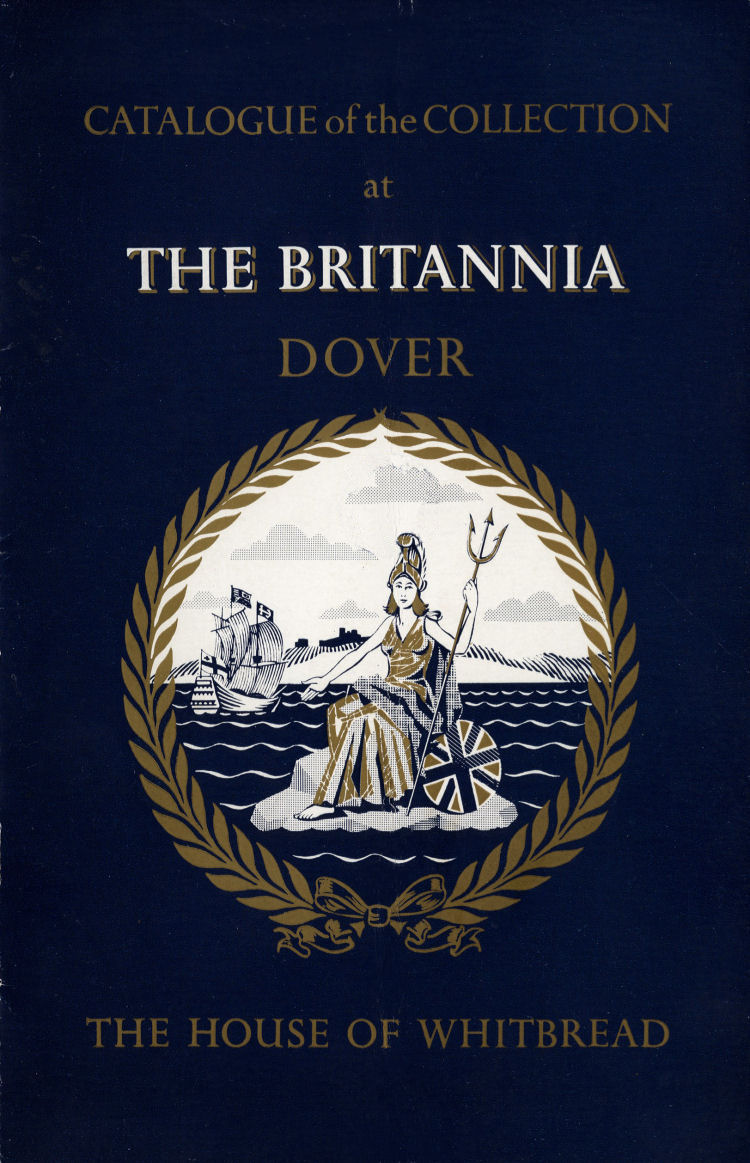 |
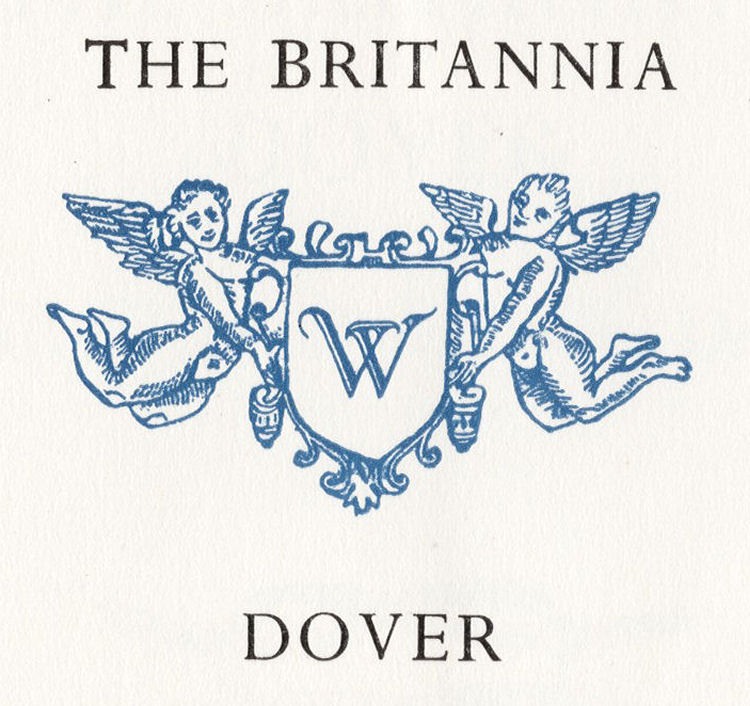 |
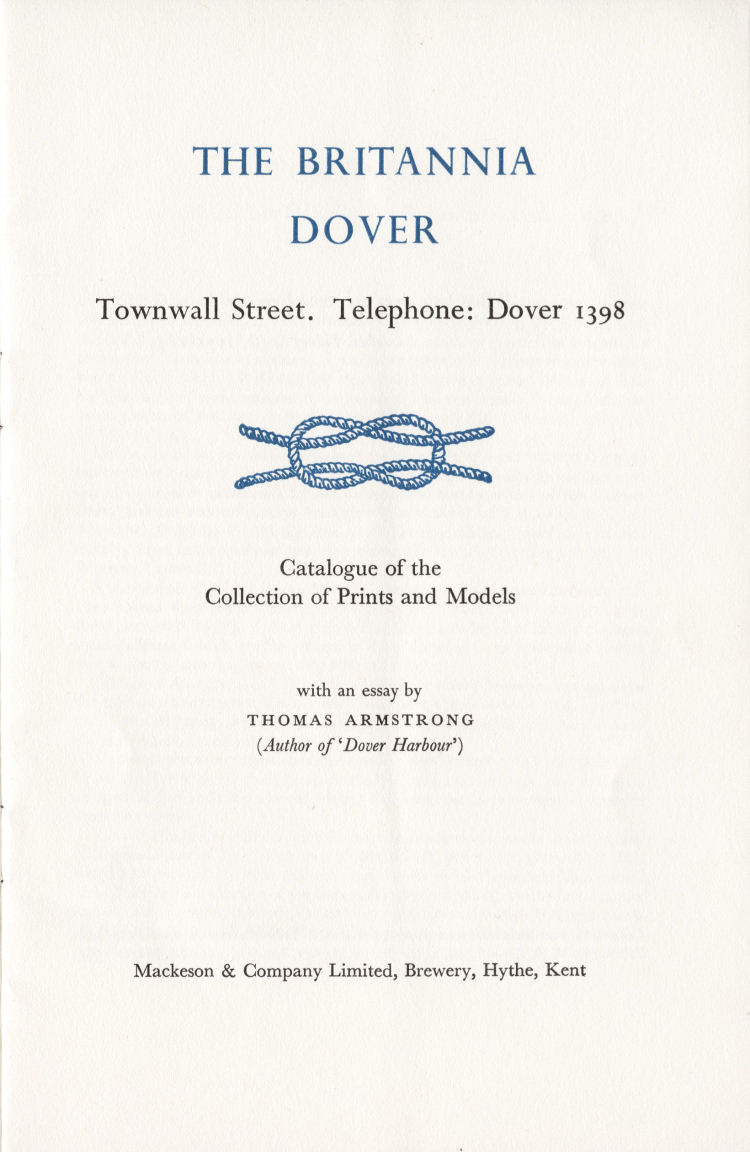 |
|
'What two ideas are more inseparable than Beer and Britannia"
Rev. Sidney Smith, 177r-1845
Collection and Brochure compiled by Richard Lonsdale-Hands Associated
Ltd. Printed by W. S. Cowell Ltd. at the Butter Market, Ipswich,
England, March 1962.
|
|
FOREWORD
by Vice-Admiral Sir Conolly Abel Smith, G.C.V.O., C.B.
In 1958 Whitbread's built a British inn named 'The Britannia' for the
Brussels International Exhibition, which became a popular meeting point
for many thousands of visitors from these islands and a place of
particular interest to others from Europe and overseas. A valuable
collection of pictures and models was available when the Exhibition
closed and this was stored with a view to building a new house on some
appropriate site in the future. Dover, with her naval tradition, has
been most suitably chosen, and the 'Britannia' opens on 26 March 1962.
Dover, famed for her white cliffs, her fine harbour and her merchant
shipping has been well named 'The Gateway of England'. Her age-old
connection with our sea power is illustrated by her selection as
headquarters of the Cinque Ports, and her name has thus been closely
associated with those of the Lord Wardens. These have included many of
the most distinguished men in our history, from among whom one may name
the Duke of Wellington and Sir Winston Churchill.
A succession of proud
ships-of-the-line have borne the name Britannia and have played their
part in nearly every great naval battle that we fought over three
centuries. Many of these fine sailing ships can be seen in the pictures,
from Britannia I with her figurehead of King Charles II to Britannia X
which was at Dartmouth during my own time as a cadet.
Certain of the
early steamships also carried the name Britannia, among them the first
ship to operate a fast regular transatlantic mail service. And, in
recent times, the Britannia airliner has taken her place among the
pioneers of long distance transport by air.
The latest of the fine ships
to bear the historic name is the Royal Yacht Britannia, in which Her
Majesty the Queen made her long tour in 1954, and which in 1957, with
Prince Philip aboard, visited the Antarctic in the course of a cruise
round the world.
Early in the last century Sidney Smith, the eminent
wit, wrote that the ideas of Britannia and of Beer, both so typically
British, are inseparable. What then could be more suitable than that an
inn at Dover should be named 'Britannia', should display a collection of
pictures and models of British craft of that name, and should provide in
these traditional surroundings that British beverage which is so closely
associated in their affection with our country and the name Britannia?
|
|
DOVER AND BRITANNIA
by Thomas Armstrong
Ever since flickering yellow flames from the Roman
lighthouse at the west end of the Castle church provided a dim bearing
to navigators, Dover has had a unique position in our affairs. For
generations its ships were entrusted with our defence, and its men, as
Men of Kent, were from the days of Canute to Henry II granted the
privilege of marching in the forefront of our armies. It meant much to
dwell within Dover's boundaries, which to seaward extended as far as a
horseman could ride at low water and still touch bottom with a spear.
The little town nestling between Castle and Western Heights has
constantly had to fear armed raiders, slaughter, pillage and rape;
fierce Vikings tumbled from their longships to attack it, and the forays
of others were innumerable. This was to continue through the centuries
to the last two great wars, in the first of which the Dover Patrol,
fighting strong currents, shifting sands and an uncomfortable anchorage
- as well as a tough enemy - earned imperishable renown. It was from
Dover that H.M.S. Vindictive and her consorts sailed in their glorious
attempt to seal Zeebrugge; and from here also, leaving behind a town
already anticipating invasion, that many of the 'little ships' put out
in the last war to bring our men home from the dunes of Dunkirk.
Dover
has always been a pearl of untold price in the eyes of any potential
invader. William of Normandy, when his succession to Edward the
Confessor was agreed, insisted that the Castle, and its well, should be
delivered to him - it is perhaps a matter for wonder that, though built
on the fringe of the sea and far above it, the fortress enjoys an
abundant supply of pure water. King Stephen, too, when challenged by
Matilda, thought nothing could avail him better than possession of the
town; and the Dauphin of France, in 1217, though the Barons who had
invited him to drive out King John were battering at the Castle,
remained uncertain of his prospects until 'the lock and key of England'
were his.
The history of Dover has always been closely linked with that
of her harbour and the long struggle to maintain and improve it. Indeed,
an all-powerful Abbot of St Martin's Priory was once brought before a
council of anxious, and certainly plucky, burghers to answer an
accusation that he had tampered with the River Dour's flow down the
valley. It had been the practice to impound water, in the hope that,
when released, a tumultuous rush would sweep away shingle at the
harbour's mouth. Many were the occasions when the Mayor and Jurats of
Dover, sitting in their lavishly decorated seats above the communion
table in St Mary's, prayed that the next operation would be fruitful.
|
|
PLATE 1
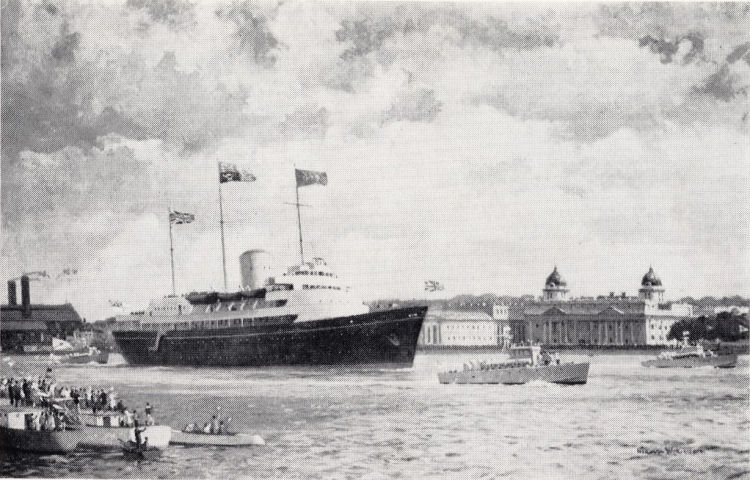
Royal Yacht Britannia, commanded by Vice-Adm: Sir Conolly Abel Smith.
G.G.V.O., G.B. passing Greenwich all 15 May 1954 with Queen Elizabeth
II on board.
|
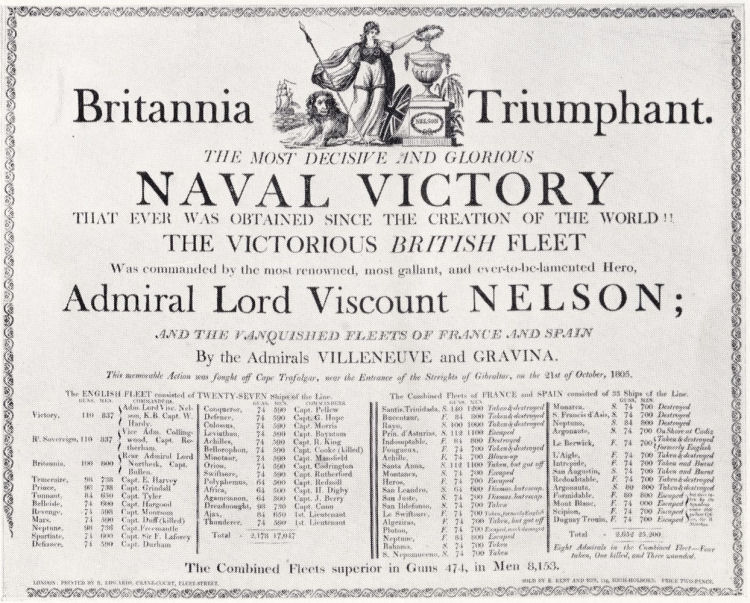
Battle of Trafalgar broadsheet, 1805.
|
|
PLATE II
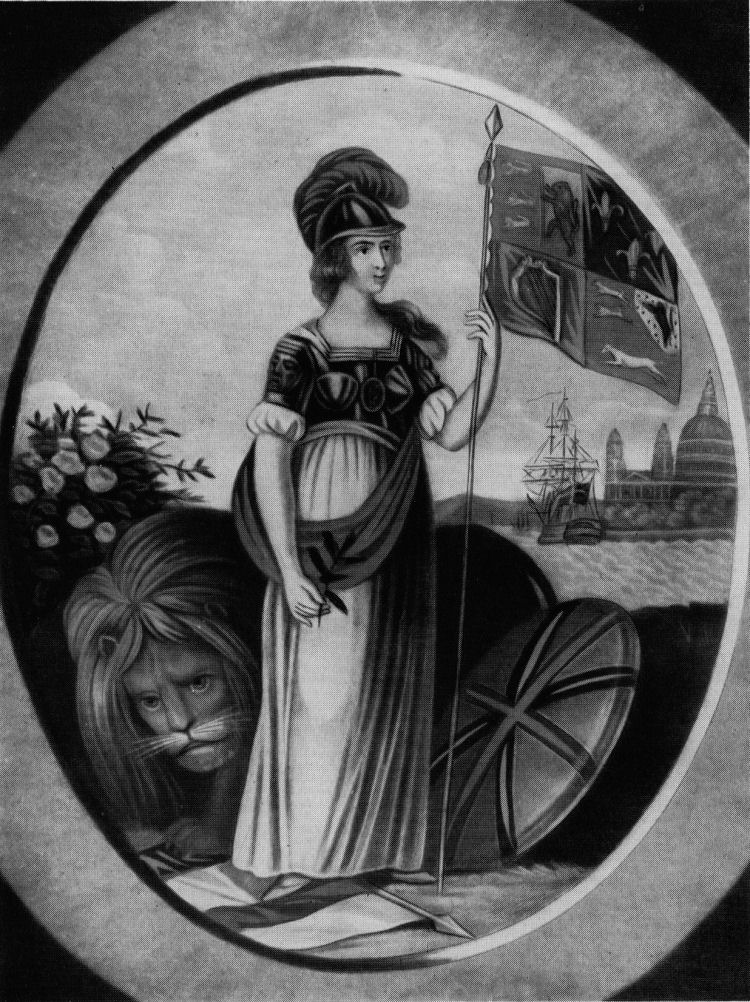
Britannia as 'An Emblem of England'. An eighteenth-century coloured print.
|
|
This long and grievous state of affairs was eventually brought to the
notice of Henry VIII, who possibly remembered the magnificent torchlight
procession with which he had been greeted in Dover before embarking for
the Field of the Cloth of Gold. His Majesty, Privy Purse swollen by
plunder from the monasteries, was graciously pleased, after grave and
sometimes festive consultations with the Fellowship of the Passage, to
promise £80,000 for a stout pier. Probably King Hal, that much-marrying
man excommunicated by the Pope, had a warm feeling for a breed of
seafarers who more than once had sailed out to intercept vessels bearing
His Holiness's Papal Bulls.
The building of the pier was begun in 1533,
the foundations consisting of twenty-ton blocks of stone hauled to the
site on a timber framework resting on reinforced beer barrels, a method
so revolutionary in Henry's view that he granted its supposed deviser a
royal stipend. Unhappily the pier failed in its purpose. The dread 'law
of eastward drift' was not to be denied; sand and shingle steadily piled
to one side, before spreading across the approach to the haven. Once
more passengers had to be carried through the surf on the shoulders of
longshoremen.
Bankers, merchant-adventurers, shipowners and
shipbuilders, faced by ruin, pleaded at Court for assistance but, apart
from purely local efforts to deepen the channel - by time-hallowed
custom all ablebodied males were expected to take a shovel at low tide
and help nothing substantial was accomplished. And years later, when the
Queen, Elizabeth I, visited Dover, the pennons of her escort fluttering
bravely as the gay cavalcade wound down from the Heights, the place was
definitely revealing signs of decay. Cannon thundered, bells rang
merrily, but the hearts of the civic fathers were heavy with care particularly the shipbuilders', aware that shortly it might be
impossible to float newly constructed craft from stocks to sea. The
general dismay was duly conveyed to Her Majesty.
Possibly the Butchers
blundered, when their spokesmen elbowed in to petition Her Grace to
release them from their obligation to deliver fats to the candle-works
at a flat rate. They were sharply refused. More probably, however, the
Virgin Queen knew that for reasons of high policy resources must be
conserved for purposes more practical than to revive a port whose fate,
her engineers advised her, would be that of Roman Richborough along the
coast; choked and vegetation overgrown.
As the years passed the menace of
Spain grew, until it was deemed imperative to raise a warning beacon on
Castle Hill. Eight towering loads of faggots and four barrels of tar went
into the bonfire, but though it came to be lighted the leaping tongues
of flame were symbols of joy. On the following day gale-driven remnants
of the shattered Armada were sighted and the seadogs of Dover, warping
their craft through the threadlike passage remaining, set across
storm-tossed waters to harry the foe further.
|
|
PLATE IIIa
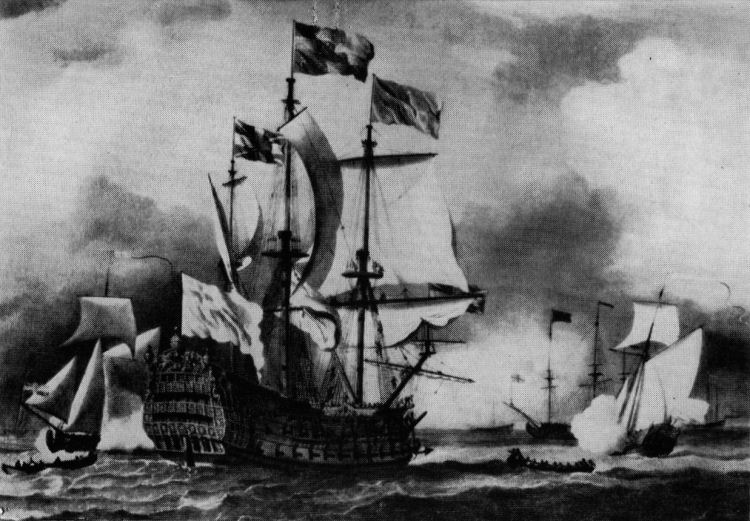
H.M.S. Britannia I, launched in 1682. |
|
A shift in the town's attitude towards near-absolute
sovereignty may have resulted from Elizabeth's parsimony; or perhaps,
later on, a whole-hearted dislike for the Stuarts developed. Certainly
two incidents involving King Charles I mightily aggrieved the
townspeople. One took place in St Mary's when His Majesty, fingers
grasping the jewelled pommel of a shoulder-high staff, declined to
accept one of those ornate seats beyond the communion table. With
censure in his dark eyes he snubbed the robed dignitaries who had been
respectfully conducting him. 'Above ... the Majesty of Heaven?' he
remarked icily before turning towards a less elevated place.
The scene
of the second was at the harbour where, the likelihood of civil war
hanging over the country, King Charles was seeing off his Queen. Amongst
Henrietta's baggage were the Crown Jewels, which she was either to sell
or pawn on the Continent to raise funds for her husband's campaign, and
many were the lowering glances cast at the iron-bound boxes containing
them. This alone may have been responsible for what happened when
fighting broke out - the seizure of the Castle for the Parliamentarians
by a party of determined merchants who, armed to the teeth, scaled dizzy
cliff heights to surprise and overcome the Royalist garrison.
|
|
PLATE IIIb
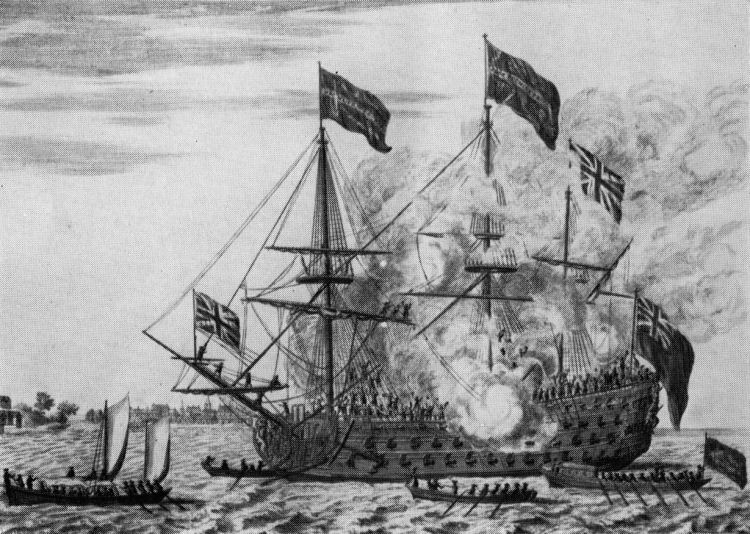
H.M.S. Britannia II, launched in 1719.
|
|
With the Restoration, a few Dover people first saw their next king, Charles II, in
effigy, as figurehead of the great three-masted Britannia; with wonder
they stared at the representation of their monarch on horseback, his
expression more angelic than the hell-rake character attributed to him.
Britannia, and a few ships before her, heralded a new naval epoch.
Edward the Confessor and the Norman Kings had entrusted much of the
maritime defence of the realm to the Cinque Ports, in which Dover's
quota of well-found vessels was 20, each manned by 21 men and pledged to
serve for 15 days annually. The bargain was by no means one-sided: in
return for footing the bill for ships and crews valuable franchises and
free tolls were bestowed. This obligation was enforced for centuries,
but finally these forces, suitable for trading and adaptable for
fighting, were supplemented by ships, the monarch's personal property,
designed solely for war. In due course the advantages of a single fleet
under the direct control of 'the keeper of the king's ships' became
obvious, and when this first Britannia was launched in 1682 the Royal
Navy was in full being.
It was as well, for from then onwards the
country was constantly at war. Until 1782 coalition after coalition
challenged us, and although we often struggled alone we also negotiated
alliances, clinking guineas frequently turning the scale. During these
long, drawn-out years the population of Dover had plenty to speculate
about, whether it was to try to assess the amount of bullion sent out on
the morning's tide or to comment most adversely, as they did in 1756, on
John Wesley, who had severely chided them in a sermon. He could hardly
have chosen a subject more inopportune. In Dover the Revenue Officers
were anathema, and almost everyone, parsons an' all - they gladly loaned
their crypts for illicit stowage - turned a blind eye to strange sights
at night: the occasional glimmer of a blue light, a lantern bobbing
along a goat-like track near Shakespeare's Cliff, or someone bending to
use flint and steel to fire a truss of straw placed in a most peculiar
spot. These signs of 'a run' were always welcome. They meant rolls of
silk brought ashore from an East Indiaman, baskets of wine, fine lace,
tea fetched from Flushing or Middelkerke, and the best in spirits, all
to be obtained at a most reasonable price.
|
|
PLATE IV
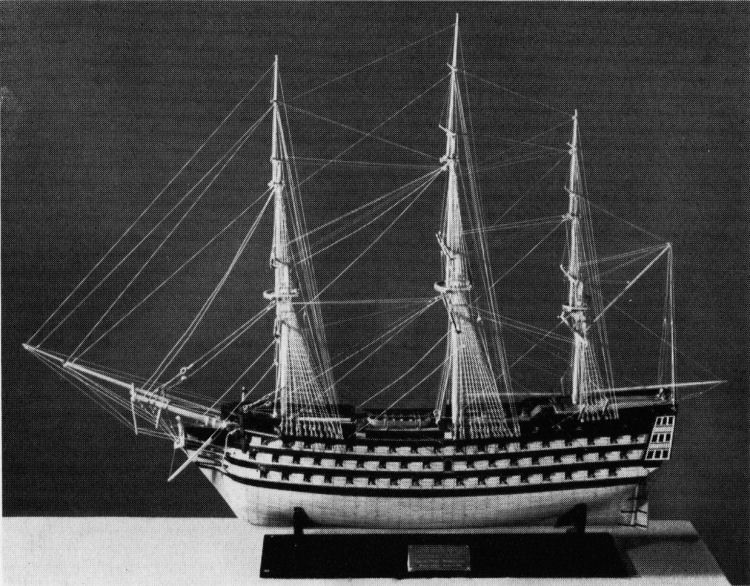
Scale Model of H.M.S. Britannia VII, launched in 1820 and broken up in
1869. She was at the siege of Sebastapol in 1854, and 5 years later was
commissioned as a training ship, first at Portsmouth, then at Portland
and in 1863 at Dartmouth; She was considered one of the most Beautiful
ships of her time. The model was made by Mr A. B. Richards.
|
|
Three years after this series of wars ended the necks
of Dover folk were craned when, pop-eyed, they watched the balloon of Dr
Jeffries and M. Blanchard rising from Castle Hill. The aeronauts crossed
to France in twelve minutes over two hours, and it is a fair bet that
that night the consumption of Mackeson's ale rose, as it always did
whenever there was exciting news or happenings. Mackeson and Company,
now a subsidiary company of Whitbread's, had been brewing in Hythe since
1669, and their lumbering artillery-wheeled wagons, drawn by immense,
full-feathered draught horses, were a familiar spectacle at the Castle
and in the flinty, pot-holed streets of the town below.
Little more than
a decade of peace was to follow before England was again confronted by a
threat as deadly as the Armada. Excepting one short intermission 'The
Great Terror' lasted for twenty-two years. Before hostilities ceased,
the name of Napoleon, who eventually was to be baulked of mastery of the
world by a meagre sea crossing, was often invoked by mothers to
discipline naughty children. 'Bony'll come over for you if you don't
behave,' they would cry.
|
|
PLATE V
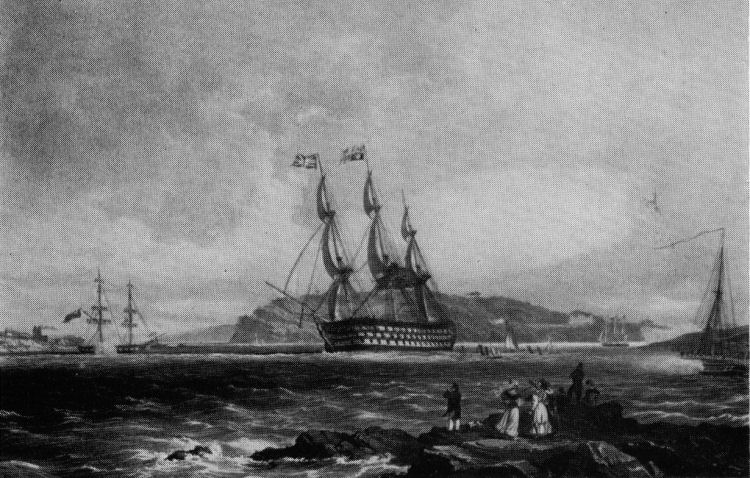
H.M.S. Britannia VII sailing out of Devonport.
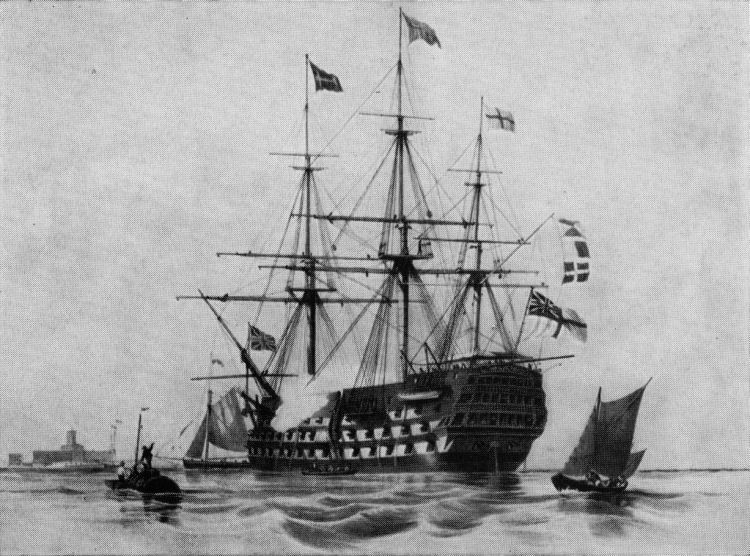
H.M.S. Britannia VII firing a salute at Portsmouth.
|
|
The war opened in 1794 with the naval victory
of 'The Glorious First of June', on the night preceding which, gleefully
anticipatory faces faintly illuminated by lanterns swinging overhead,
the crew of the Brunswick made the most of 'Rule Britannia', a proper
prelude to their bloody duel with the Vengeur when daylight came. For
months and years after that there was little to sing about, but never
for a day, although shortages increased, could it have been boring in
Dover. There were strange allies to puzzle over at one time, 17,000
savage Russians encamped thereabouts; and all the thrills of continuous
peals of bells, transparencies and illuminations when, in 1801, a French
emissary sailed past the south pier-head, now in a deplorable
condition, holding aloft a peace treaty in a gold box.
The respite
lasted fourteen months, and from then onwards the aftermath of fierce
gales were periods of acute tension for Dover; if the Navy's
sail-of-the-line were blown from their blockading stations off the
Corsican Ogre's ports his invasion barges might slip out when the wind
died, before our weather-beaten ships could return. In these hours the
quietness of resolution brooded over the town; drums beating to arms
were heard just that more clearly.
|
|
PLATE VI
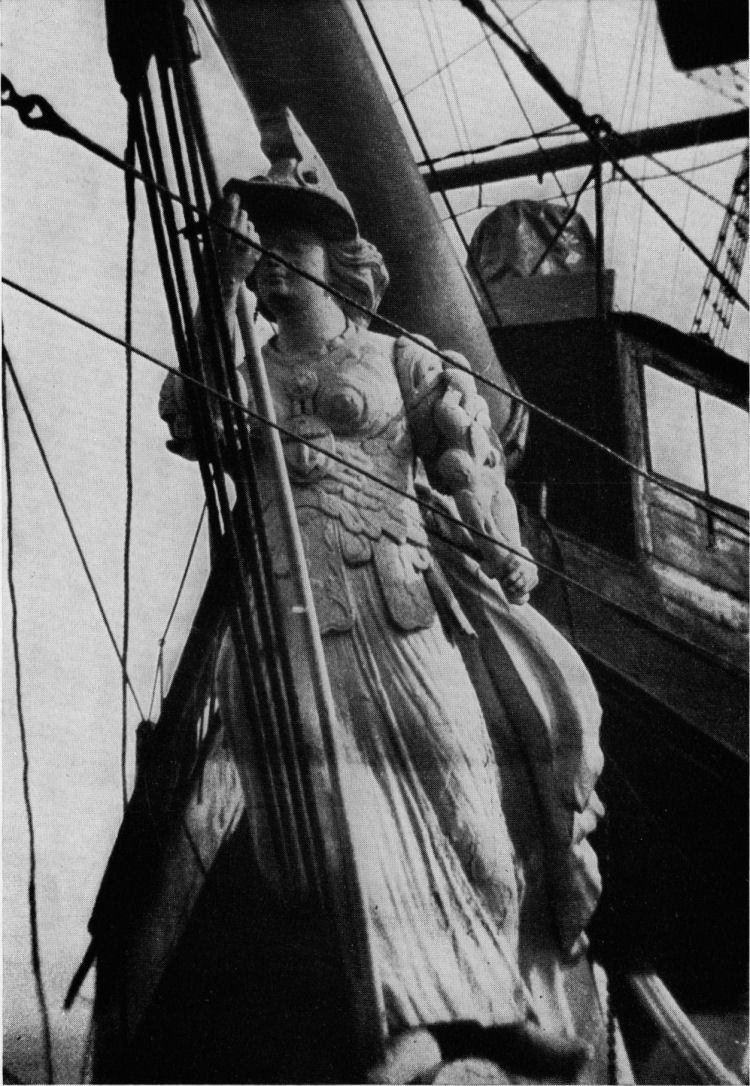
Figurehead of H.M.S. Britannia X, the last sailing ship of that name,
which from 1869 till 1914 was stationed at Dartmouth as a training ship.
|
|
Security was not as it is now, and on
a summer day in 1804 Dover folk flocked to the harbour to inspect a new
weapon invented by an American gentleman, a Mr Fulton. Some days later
Castle Hill and the battery positions on the Western Heights were thick
with spectators: pretty young women in duty-free muslins and saucy
bonnets, apprentices in filthy clothes, servant girls in mob caps, and
hosts of gaitered Fencibles in white pantaloons. Spy-glasses were
generously passed round, with everyone eager for a faint glimpse of the
action at Boulogne, where Mr Fulton's torpedoes, canisters of explosives
on wooden frames, were being tried out. Whatever damage was done could
not be observed, but the melancholy-looking Napoleon remarked that the
effort had served nothing better than to 'break the windows of the
honest citizens of Boulogne with good English guineas.' A second gesture
of scorn, and supreme confidence, was contained in instructions to the
French Mint, who at once energetically began to stamp medals purporting
to have been struck in London - frappé
à Londres. They were intended for
distribution to the 'Army of England' immediately it was in control of
the shopkeepers' capital. Shortly before this, Wordsworth wrote these
lines:
'Vanguard of Liberty, ye Men of Kent,
Ye children of a soil that doth
advance
Her haughty brow against the coast of France,
Now is the time to prove your hardiment!'
|
|
PLATE VII
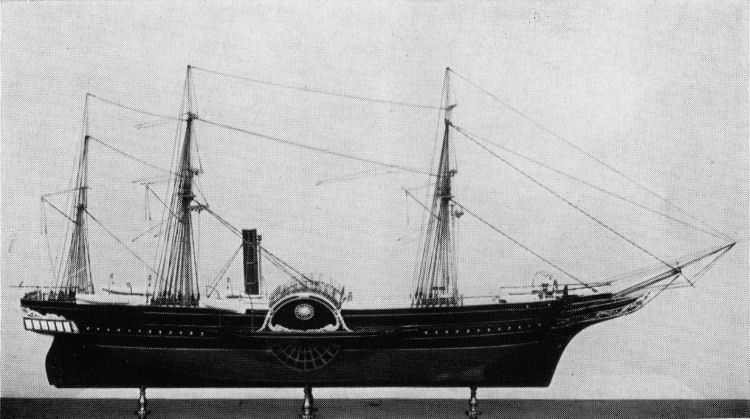
Model of P.S. Britannia, built at Greenock in 1840, the first steamer
built to carry the transatlantic mails.
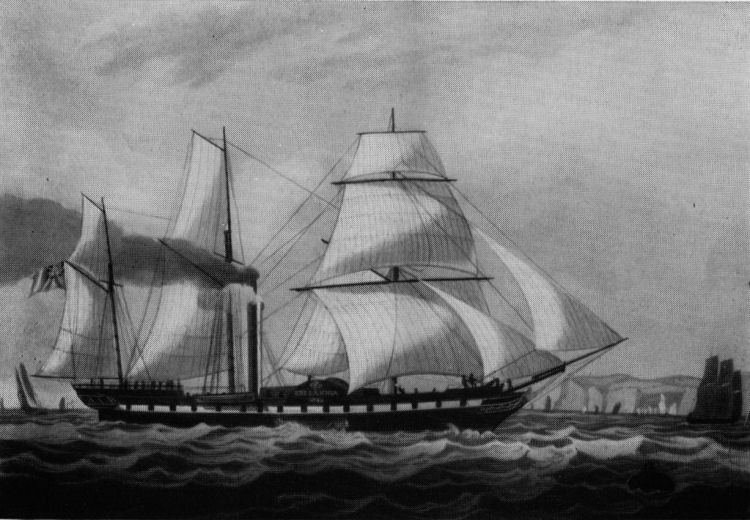
P.S. Britannia, an early steamship, launched in 1835, and used on
British coastal services.
|
|
Invasion talk ended in the autumn of 1805, when, in the mists of an
October morning, the third Britannia, following the lead of Victory in
the Weather Division, broke the line of an immense Franco-Spanish fleet.
When the roar of guns ceased and flames and billowing smoke died away,
so that Cape Trafalgar was again visible, Napoleon's naval power was no
more. But Trafalgar was not ripsnortingly celebrated in Dover. Strong
ale was indeed drunk on the evening the semaphores of the Admiralty's
string of land-telegraph stations from London transmitted the news, but
tankards were raised sadly. What victory was worth the life of Britain's
Hero? Lord Nelson was gone, and never could there be his like. Every
man, woman and child wore mourning crape; the whips of every stage-coach
and chaise - and there were many to cater for the passenger trade -
carried streamers of broad black ribbon.
Waterloo came ten years later
and for long after that, untroubled by any major war, England devoted
her effort towards gaining the world's manufacturing supremacy.
Unhappily Dover's trades had scant share in the new affluence, and even
the sail-lofts were only moderately busy after the worst of storms. As
for traffic at the harbour - well, at the close of the previous century
a channel sufficient to permit the reception of an 800 ton vessel had
been cleared; but now, despite Herculanean efforts, merchants were
restricted to importing goods in craft far smaller - 'whose burthens
allow entry' was the operative clause. Chafing, they read in 1840 how
the P.S. Britannia, the first engined ship built to carry transocean
mails, had no difficulty in crossing the Mersey bar when inaugurating a monthly service between Liverpool and New
York.
Fifty years before, however, a seed had been sown, the suggestion
that a national harbour should be created at Dover. It was made by
William Pitt, Prime Minister of England and Lord Warden of the Cinque
Ports, who in days of excruciating peril did as much for his country as
our own beloved Sir Winston has done for us. This bore fruit
ultimately, and in 1847 the Admiralty Pier was begun. As this massive
arm was to extend as far as the true tide, hopes were high that soon the
biggest of ships would call regularly; even greater were they when,
enormous expenditure most disturbingly not having achieved the aim,
Parliament in 1896 decided to make an artificial harbour with a depth of
not less than thirty feet at low water.
So the century ended, with
another starting in which doubts about Germany's intentions gradually
dominated men's minds. Inevitably, as it seemed, the First World War
came. The inhabitants of Dover, in the front line and more sternly
blacked out than the remainder of the country, could see the brilliant
stabs of light when the destroyers of the Dover Patrol were in action
inshore, and suffered bombardment from the air, though with bombs far
more puny than those to be experienced in the Second World War.
Dover
has seen it all; from the broad swords of the Roman legions to the
vapour trails of the Battle of Britain; St Augustine's monks bringing
Christianity and couriers racing with tidings which could make Princes
arrogant or abject. It has seen Spaniards auctioned in the market place,
and watched a harbour which, for all its grandeur, still has more vacant
spaces than is desirable - for those fierce currents are still there to
plague. Knights have lodged in the Maison Dieu before departing on
Crusades, camp-followers have paraded its streets, and pilgrims, ravaged
by disease, have tottered into St Bartholomew's Hospital for Lepers to
rest. When inland cities regarded foreigners with suspicion Dover took
them in its stride. Huguenots and others fleeing from religious
persecution sought its shelter, and the emigré nobility of France were
brought to safety in its luggers.
Redolent with two thousand years'
history, Dover is a sheer delight to those with imagination enough to
search out its old buildings, defensive positions, and the relics of
sailors, soldiers and divines. If there is one spot in England where the
spirit of Britannia can most consciously be felt, it is surely here in
Dover.
|
|
PLATE VIII
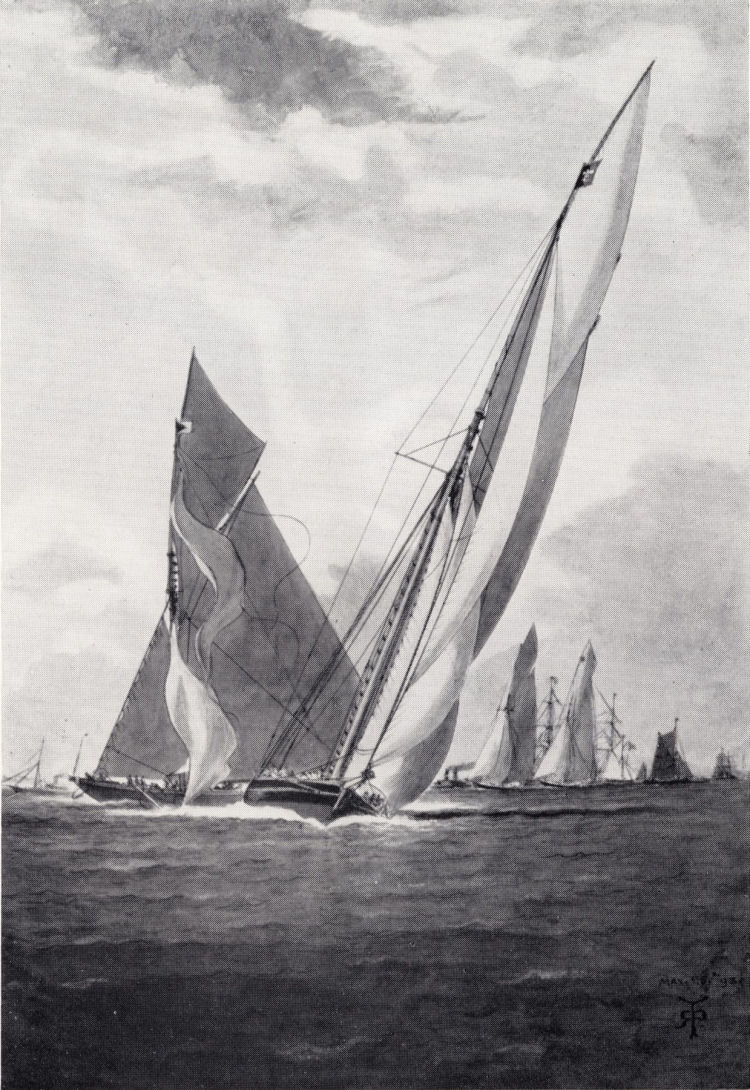
The racing yacht Britannia, built in 1893 and owned by King Edward VII
when Prince of Wales.
|
|
Catalogue of the Collection of Models, Pictures and other items
displayed in 'The Britannia'
MODELS
a. A fine scale model of H.M.S. Britannia VII is shown in the Britannia
Bar.
This 120 gun ship of the line, which is also shown in frames 3, 4 and 5,
was launched in 1820 and broken up only in 1869. She was a beautiful
vessel, 205 feet in length, and was a great favourite of marine artists.
The model was made by Mr A. B. Richards. Plate IV.
b. A model of the Bristol 'Britannia' 310, prop-jet airliner is shown in
the Restaurant. The 'Britannias' are powered by four Bristol Proteus
engines, each developing 4,120 t.e.h.p, and have a cruising speed of
around 400 m.p.h. with a range of nearly 6,000 miles. Behind the model
is an aerial photograph of the Kent countryside taken from 7,000 feet.
PICTURES
Wooden Walls
1. Reproduction of a painting of H.M.S. Britannia I, launched in 1682,
of 100 guns. The figurehead was an effigy of King Charles II on
horseback. Plate Ill.
2. Coloured engraving of H.M.S. Britannia II, launched in 1719, 1,894
tons.
She carried 100 guns, and a crew of 780 men. Plate Ill.
3. Coloured aquatint of H.M.S. Britannia VII cruising off Malta. The
ship was launched in 1820, of 2,602 tons, and carried 120 guns and a
crew of 900.
4. Coloured lithograph of H.M.S. Britannia VII firing a salute at
Portsmouth on the occasion of Queen Victoria's birthday. Plate V.
5. Coloured lithograph of H.M.S. Britannia VII leaving Devonport, while
salutes are fired by other vessels. This ship landed 200 men at
Sebastopol in the Crimean War, and was finally broken up in 1869. Plate
V.
6. Coloured aquatint of the launching of H.M.S. Nelson - 120 guns - at
Woolwich in 1814, after a painting by J. T. Serres, Marine Painter to
H.R.H. the Duke of Clarence.
7. Photograph taken in 1903 of the figurehead of H.M.S. Britannia X, the
last sailing ship of that name. This vessel had auxiliary steam and was
launched in 1860. She replaced H.M.S. Britannia VII at Dartmouth as a
training ship in 1869 and remained there until 1914 when she was sold
for breaking up. Plate VI.
Naval Victories
8. A large coloured engraving, commemorating 'The Glorious First of June
1794', on which Lord Howe achieved his famous victory. A figure of
Victory crowns Britannia, and portraits of the Admiral and his captains
are depicted.
9. Photograph of a painting by H. P. Briggs showing King George Ill,
accompanied by the Queen, presenting a sword of honour to Lord Howe
aboard his flagship the Queen Charlotte, on 26 June 1794. A photograph
of the jewelled sword and its scabbard is also shown: these are now in
the possession of Earl Howe.
10. A broadsheet entitled Britannia Triumphant commemorating the naval
victory at Trafalgar and the death of Nelson on 21 October 1805. Plate
I.
Royal Yachts
11. Lithograph of the Royal Yacht, Victoria and Albert II, 1855-1904,
shown leaving Gravesend in February 1858.
12. Photograph of a painting by Norman Wilkinson of the Royal Yacht
Britannia. This picture, which is in the National Maritime Museum,
Greenwich, shows the ship with Queen Elizabeth II on board, passing
Greenwich on her return to England on 15 May 1954. Plate I.
13 & 14. Four photographs of the Royal Yacht Britannia.
Steamships and Sailing-ships
15. Coloured aquatint of P.S. Britannia of the General Steam Navigation
Company, launched in 1835. She was of 550 tons, and employed both
paddles and sail. Plate VII.
16. Photograph of a model of P.S. Britannia, built at Greenock in 1840,
which is at the Science Museum, South Kensington. This ship of 1,156
tons gross, belonged to the British and North American Royal Mail Steam
Packet Company, and with her sister ships established a monthly
transatlantic mail service. Charles Dickens crossed in her in 1842.
Plate VII.
17. An illustration of the cabin occupied by Charles Dickens in the P.S.
Britannia (item 16), on his voyage to America in 1842.
18. Water-colour painting of the racing yacht Britannia, built in 1893
and owned by the Prince of Wales, later King Edward VII. The yacht is
shown passing the Valkyrie of Lord Dunraven. Plate VIII.
19. Oil painting by John Terry of the three-masted grain clipper Blair
Athole, built in 1874, of 1,697 tons.
Emblematic Prints
20. An eighteenth-century coloured print, showing the figure of
Britannia as 'An Emblem of England'. Plate II.
21. An eighteenth-century coloured print in which 'Britannia ever views
with smiles, Our prosperous and United Isles'.
22. Three nineteenth-century coloured prints of Britannia.
Views of Dover
23. Coloured engraving The South Prospect of Dover showing the harbour,
town and castle, published in March 1739. An 8-foot photographic
enlargement of this interesting print is also displayed in the
Restaurant.
24. Coloured lithograph View of Dover from the Heights by T. S. Cooper,
with a view of the coast of France, published by W. Batcheller at Dover
in 1825.
25. Coloured lithograph View of Dover from Waterloo Crescent by W. R.
Waters, published by Geo. Warren at Dover about 1850.
26. Map of Kent published in 1837 by Moules, with views of Dover,
Rochester and Greenwich. It displays the arms of Kent, of the Marquess
Camden (Lord Lieut. for Kent), and the episcopal arms of Canterbury and
Rochester.
Grateful acknowledgement is made for the valuable assistance in
preparing the Collection given by the Admiralty; the National Maritime
Museum, Greenwich; the Science Museum, South Kensington; Earl Howe, and
the British Overseas Airways Corporation.
|
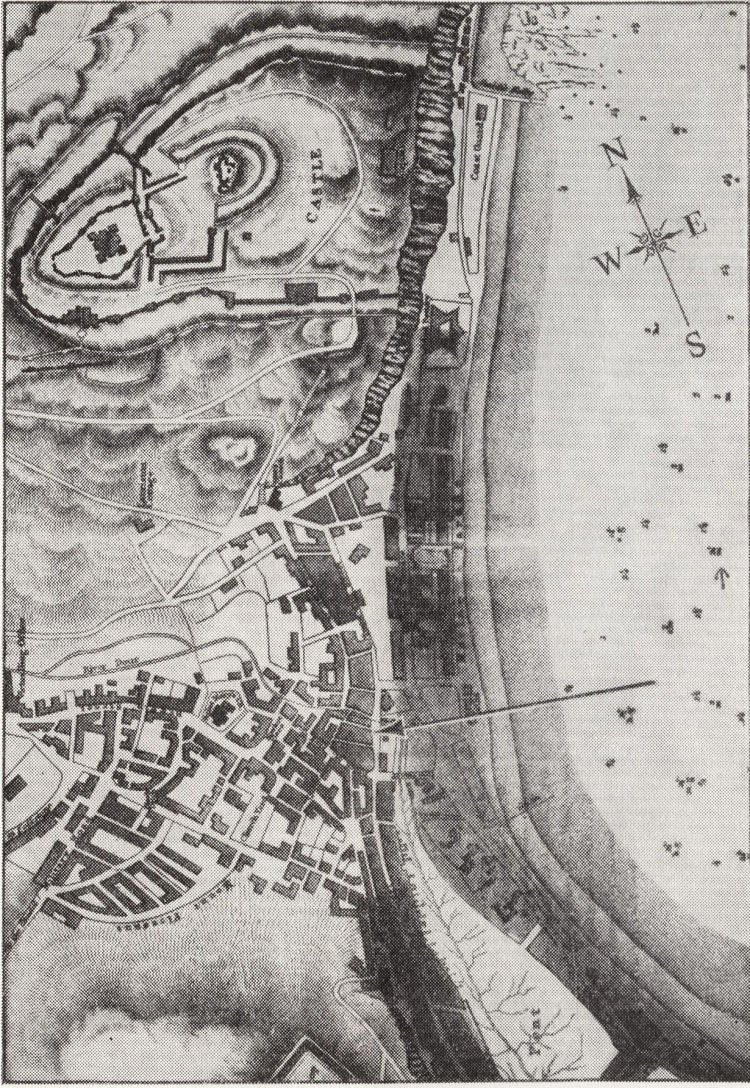
Portion of a map of Dover published in 1833 from a survey by Mr J. Scott
Tucker. The arrow shows the site of the' Britannia', previously an inn
named' The Wine Lodge'.
|
|
Some other Mackeson Houses
Bell Inn HYTHE
British Lion FOLKESTONE
Clarendon SAND GATE, NR. FOLKESTONE
Falstaff Hotel CANTERBURY
Foy Boat Hotel RAMSGATE
King's Arms SANDWICH
King's Head HYTHE
Palm Tree ELHAM, NR. CANTERBURY
Red Lion STODMARSH, NR. CANTERBURY
Royal Oak Motel NEWINGREEN, NR. HYTHE
Seabrook Hotel SEABROOK, NR. HYTHE
Ship Hotel DYMCHURCH
White Hart Hotel HYTHE
White Horse BRIDGE, NR. CANTERBURY
White Horse CHILHAM, NR. CANTERBURY
Wool pack SMEETH, NR. ASHFORD
|
|
From the Kent Mercury 13 January 1967
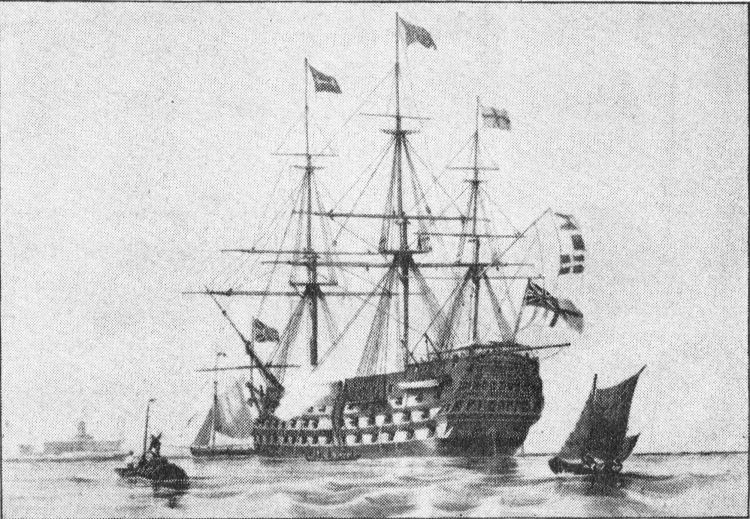
HMS BRITANNIA From a contemporary print, one of more than 30 pictures
photographs and models on show in the new house. This unique collection
was originally assembled for the Britannia Inn, built by Whitbread &
Co., Ltd. at the Brussels Exhibition, 1958. |
|